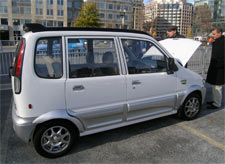The main focus of the Electric Drive Transportation Association (EDTA), and of the conference, is to empower corporations and individuals and to foster collaboration, allowing a consolidation of EV technologies. They support new technologies by lobbying the US federal government and bringing to one table all the current incentives in order to aid the fledgling movement.
Participants in the December symposium took full advantage of the exhibition halls, test drive opportunities and seminars, brainstorming on the issues with like-minded colleagues.
The vehicles in question are known collectively as plug-in electric vehicles (PEVs), and are divided into the following classes:
- Battery: Batteries power an electric motor that propels the vehicle.
- Plug-in hybrid: Electricity is used to move the vehicle's wheels. Some, or all, of that electricity comes from the power grid – from ‘plugging in’.
- Hybrid: Both an electric motor and an internal combustion engine (ICE) propel the vehicle.
- Fuel cells: Hydrogen fuel and oxygen are combined to produce electricity, powering an electric motor that moves the vehicle.
During the conference, two plenary sessions were held – the Energy Policy Roundtable and The State of the Industry. Below is a summary of the topics that were discussed.
Energy storage systems, including batteries and super conductors
 One of the first things mentioned struck a chord with attendees. Mil Ovan, cofounder of Firefly Energy, said, ‘I believe it’s important that the United States not trade a reliance on foreign oil for a dependence on batteries made overseas.’ Currently there are no large-scale battery manufacturers in the US!
One of the first things mentioned struck a chord with attendees. Mil Ovan, cofounder of Firefly Energy, said, ‘I believe it’s important that the United States not trade a reliance on foreign oil for a dependence on batteries made overseas.’ Currently there are no large-scale battery manufacturers in the US!
Ovan also said, ‘You can’t bet on just one technology.’ According to Ovan, failing to diversify was a mistake the Bush administration made when it committed hundreds of millions of dollars to research on fuel-cell technology while spending considerably less on standard battery technology. ‘Despite all the funding, we’re no closer to a fuel-cell-powered vehicle than we were 10 years ago.’
The focus should be on pure electric and hybrid (in series), better options for Bermuda. Hybrid in parallel is a good highway option for the US, but is not ideal for Bermuda’s driving patterns. It also seems that while Europe is undergoing a diesel revolution, the US is not considering this option at all.
The general message of the session was that the technology innovators should collaborate, become less proprietary and standardise, and stop relying on overseas imports.
Greening the grid with renewable energy
Geo-thermal, wind, solar and bio-mass are the most common renewable energy sources in the US. Most utility companies have been mandated to produce a certain percentage of their power solely by renewable means. The vast majority are far behind in terms of reaching that target within the allotted time frame. California seems to be the most advanced in greening the grid, with some companies now producing 14 to 20% renewable energy. They also tend to have the largest fleets of EVs.
One power innovation involves the use of smart meters, which allow utility companies to view the current consumption of a client based on their appliances and inform them where cuts in energy usage could be made. There is hope that at least five million smart meters will be in use in the US within five years.
Where transportation is concerned, the US government wants at least one million EVs on the roads by 2015. This is certainly an achievable goal in the next 10 to 15 years. However, there will need to be more availability of batteries and another 160 power stations to fulfil the needs of all the planned PEVs and PHEVs.
Electric cars and commercial vehicles available today
Greenrock’s last article on EVs, ‘Are electric vehicles the way forward?’, discussed some of the cars that are currently available, so we will not revisit that here. In addition to cars, many of the EVs on display at the conference were large, resourceful commercial machines.
 One example is the self-sufficient bucket truck pictured left. It arrives at the site on ICE power then parks and switches the engine off. At this point the silent electrical component takes over with enough power to operate all the tools and diagnostics of the vehicle. No more diesel engines thumping outside your house at 2 am! DUECo and Smith have very large trucks on the road which have speeds that surpass 60 mph and can travel 120 miles (most routes are only 20 to 50 miles) on a single charge … fully loaded.
One example is the self-sufficient bucket truck pictured left. It arrives at the site on ICE power then parks and switches the engine off. At this point the silent electrical component takes over with enough power to operate all the tools and diagnostics of the vehicle. No more diesel engines thumping outside your house at 2 am! DUECo and Smith have very large trucks on the road which have speeds that surpass 60 mph and can travel 120 miles (most routes are only 20 to 50 miles) on a single charge … fully loaded.
In the US, the public transportation board has vowed that by 2030 all buses will be non-emitters. This amounts to a huge savings in fuel and a massive reduction of carbon pollutants.
Building an infrastructure for topping up EV batteries
There are two schools of thought on this. One is to provide charge bays that are interpretive and collaborative in appropriate areas in addition to a series of battery swap stations. Charge stations should be dispersed around city centres, malls, grocery stores, apartment blocks, underground parking lots in company buildings, and so on.
The charge stations would use purchased plans, similar to cell phone usage plans. Swipe cards give access to chargers around the world, assuming a single-company charger system, and parking areas would be reserved for EVs only. The chargers are intelligent and communicate with the user, the host of the charge bays and the utility company. In addition, users would be able to go online to see which chargers are available in a certain area, thus allowing journey planning. San José and San Diego are the first to try this system, although the UK has had some charge bays in place for a few years.
The second option is Project 'Better Place'. In this scenario batteries would have to be standard across the range and easily accessible. This would enable the exchange of a depleted battery for a newly charged one at a swap station in the same time it takes to pump fossil fuel into a vehicle. In this case only a small inventory of batteries would need to be kept.
This option is being adopted in Israel and Denmark, and in a trial project in California. Hawaii has also shown an interest in following this model. At present there are 50 such swap stations in Israel, which is planning to add 500,000 more by 2012.
For more information about EVs and the topics discussed here, visit the EDTA website at www.electricdrive.org.




